
Something didn’t work out. Now you want to delete a book after it is published.
It can happen for a lot of reasons. You self-published a book on Amazon and got some terrible reviews.
Perhaps you had a change of heart about the subject of your Kindle ebook.
For whatever reason, you want to delete your book and stop any further distribution.
You can’t completely delete a book after it is published
If you want to delete all traces of your book or ebook from Amazon or any other online book retailer, you can’t.
I know that’s not what you want to hear.
All you can do is unpublish and remove it from distribution and sale.
I’m not a fan of Goodreads, but it gives a good explanation as to why you can’t completely delete a book.
Just as a library would not remove a record from its catalog, so do we not remove books from our database.
If you are an author on Amazon KDP, these notes from KDP help explain what happens when you unpublish a book or Kindle ebook.
You can’t delete books that have been published. Also, paperbacks that were assigned an ISBN can’t be deleted. When you unpublish an eBook from the Kindle Store, it becomes unavailable to buy and unsearchable on Amazon. It won’t be available for purchase until you republish it.
When you unpublish your paperback, customers won’t be able to buy new copies through KDP. Third parties may still sell used copies of your paperback on Amazon. That means your paperback’s detail page will stay live on the website. However, customers won’t be able to buy new copies through KDP unless you republish your paperback.
If you have self-published a book and now want to delete it, all you can do is unpublish it.
The same applies if you are managing the books of a deceased self-publishing author. This will remove it from sale and distribution. However, it will not stop possible sales by third parties on mass-market distribution.
Unpublishing an ebook
On most self-publishing platforms, you only need to unpublish your ebook.
On Amazon, click on the hamburger menu next to your book. Then click Unpublish eBook.
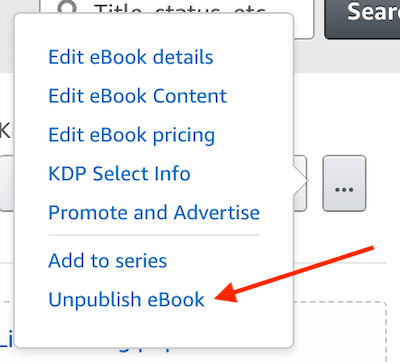
Your Kindle ebook will be filed as a draft in your dashboard. But you cannot delete it.
It is a similar process for Smashwords and Draft2Digital. However, Draft2Digital does have a delete option.
Your ebooks will be removed from sale and distribution, and your ebook detail page will return a page not found result.
However, anyone who bought your ebook or downloaded it for free will still have a copy.
There is no way to remove your ebook from a reader’s device or ebook library.
If your ebook is available in Kindle Unlimited via KDP Select, readers who have started to read it will be able to finish reading it.
It will also remain on sale for your current ninety-day enrollment period in KDP Select.
You can check the remaining time of your enrollment by clicking KDP Select Info from the hamburger menu.
You will see this warning when you unpublish your Kindle ebook.
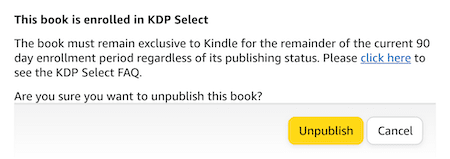
Once you click unpublish, your ebook will be removed at the end of your enrollment period.
Unpublishing a print book
You can use the same process to unpublish your print-on-demand paperback on Amazon.
Select your title on your KDP dashboard and unpublish it the same way as for an ebook.
But unlike an ebook, Amazon will not remove it from sale altogether.
It will remain listed and available on Amazon as an out-of-print or mass-market book.

Copies of your book may remain available through other third-party sellers on Amazon.
It’s similar to selling used books in a secondhand bookstore, so it is something you can’t control.
Once you publish a physical book, the ISBN will remain in book databases forever.
There is no way to delete all traces of a book completely.
More Reading: Why It’s Impossible To Delete A Print Book After Publishing
Archive your unpublished books
On the KDP dashboard, you can archive your unpublished titles.
When you do, you won’t see them appearing on your bookshelf any longer.
To archive a title, click the three-dot menu, and click the Archive Title option.
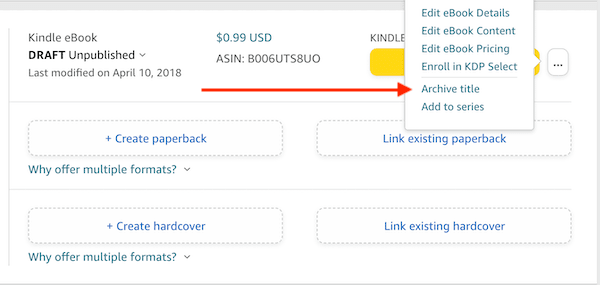
Now you will only see your published books that are available for sale.
Your Amazon Author Page
If you have unpublished your book or all your books, you won’t like this.
There is no option to delete an Amazon Author page.
When you unpublish a book, Amazon will remove it from your Author page. But any other data, details, or images about you as an author will remain.
All you can do is remove as much information as possible with the edit options on your Amazon Author page.
Remove your posts from social media
If you delete a book after it is published, don’t forget to delete your posts from Facebook, Twitter, or other platforms you used.
It might be a slow process and time-consuming if you shared a lot of book promotion posts.
But if you want to remove all traces of your ebooks or books on social media, it might be worth the effort.
With the Internet, it’s extremely difficult to delete your writing and posts entirely. All you can do is do your best.
Republishing a previously published book
Because your removed books go into a draft file, you have one other option.
You might consider editing, changing, or repackaging your old book.
It’s possible to republish a book with a new title and cover, and it will be like publishing a new book.
Sometimes this is a better option than trying to delete a book. It gives you a second chance to try and succeed with your book.
It will also mean that your new version will replace your unpublished version, so it will not result in a dead link or blank sales page.
The only possible drawback to this option is that if you got a lot of poor book reviews, they will remain on your book’s sales page.
Summary
Very few new authors think about how to delete a book from KDP or other platforms when they write and publish a book or ebook.
It’s an exciting time, and all you want to do is get your book or ebook published and available for readers to buy.
But once you are a published author, you will remain a published author forever.
There is no way that you can completely delete a book after you publish it.
However, removing your title from sale is relatively easy if you only published an ebook.
It will not show on any listing or sales pages after you remove it. But your author name will still appear on the Amazon Author Page.
For a paperback, though, removing your title from book databases and its Amazon sales page is impossible.
All you can do is use the delisting process to remove it from being directly available for sale.
Related reading: Can You Opt Out Of KENP Kindle Unlimited With KDP Select?

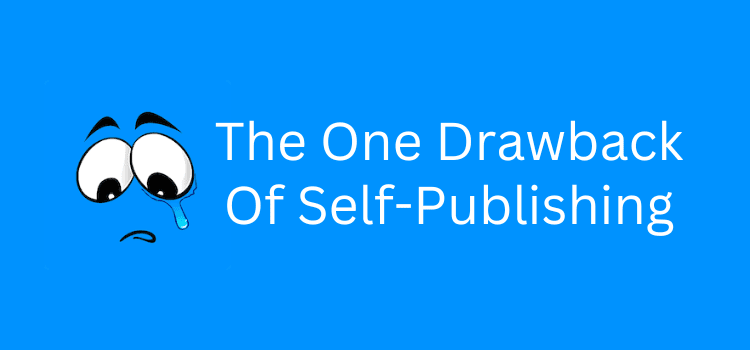

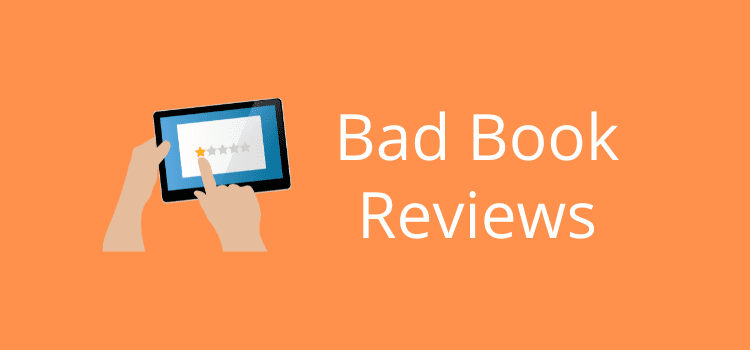
Hello is it possible for me to remove my paperback from Amazon along with the ebook and publish it on D2D instead, I have barely made any sales and I don’t know if I made the right decision in putting the book on Amazon, but I also don’t want to receive any sort of legal trouble whatsoever
Yes, you can change your publishing strategy at any time.
As long as your ebook is not enrolled in KDP Select, you can publish with D2D.
Amazon Author support? What are you talking about? Amazon’s author support is a marketing gimmick – it does not exist. I shifted my publishing to D2D. They support you every step of the way with real people answering your questions with specific responses and answers, usually within 24 hours.
What if an old publisher doesn’t unpublish one of your old books?
It depends on who owns the rights, Kathleen. If it’s the publisher, then there is not much you can do other than ask.
Hi Derek,
I am publishing a book; my publication date is 27 March (already set in IS, Nielsen, included in my pending Goodreads page, etc), but unfortunately I accidentally published the paperback on Amazon yesterday (thinking there would be a pre-order option). I have unpublished the book and it is not, and has never been, available for distribution.
Is it possible to get the publication date on Amazon changed?
What I would like to do, is have the book available for pre-order (which can be done on Amazon via Ingram Spark, I have been told) from 20 March, with publication date of 27 March. But of course, if I set up the IS pre-order with the 27 March date but the Amazon page itself falsely claims the publication date is 15 March, it will cause confusion. Do you know my options in this scenario?
Thanks very much,
Paddy
You’ll have to contact KDP support for this issue, Paddy.
It’s the only possible way to get your date changed.
Assalamu Alaykom
I submitted the log book to my KDP account 3 days ago. The book is live. But there is a problem that 1 word is wrong in the subtitle. How can I correct this mistake, if you tell me a little, I will be especially benefited. Thank you.
Simply change the details of your book’s subtitle from your KDP dashboard and republish your book.
The changes will usually update within 24 hours.
Hi Derek, – hope ur well! I published my book on kdp in January 2023. But never promoted it. Had softcover there. I then changed my mind and decided to have the book printed overseas . I will be getting my books end of July 2023 and I want to sell them through Amazon FBA and Amazon FBM and some via my website where is ship from my home. I cannot remove the kdp version even though I’ve disabled sales. The isbn is all the same.. I want to warehouse them at Amazon so that I don’t deal with All shipping and also to eventually get Amazon reviews. I’m wondering…. Will this be an issue when I want to send my books to Amazon FBA?
You might have to check this with Amazon, Jen.
You have the same ISBN, so I doubt there is a way to remove your KDP POD version.
But I’m unsure how the two versions will show on your sales page.
If I self-publish through KDP (accepting the free isbn) and later decide that I would like to unpublish from KDP and publish elsewhere, would I legally be allowed to do that? I understand that the reviews would remain under the free isbn so in that case it would almost be like leaving a record of a past version of the book, but I’m just wondering if Amazon’s isbn keeps me locked in to the extent that I wouldn’t be allowed to publish elsewhere, even if I unpublish my book with KDP. I hope my question makes sense! I am super new to this so it may be a bit uninformed and therefore incomprehensible. :)
Yes, you can use a free Amazon ISBN and then publish elsewhere with a different ISBN, Ben.
But it would be better to start the right way and use one ISBN wherever you publish your book.
Amazon allows you to use your own ISBN.
If you have different ISBNs for your book, your sales data and reviews will be split.
Thanks for this article, Derek.
In short, you’ve covered all ways that one can or can’t delete a published book. I haven’t found any hard deletion methods around what you’ve already mentioned although a softer delete option may exist if Amazon allows it…
Even if one *inadvertently* self published a paperback book perhaps out of anger, frustration, haste or some other negative emotion (without thinking it through properly) at the time they will NEVER be able to remove it from the Amazon website. Always best to keep any compulsive self publishing to Kindle eBooks only as they CAN be removed and the sales page will 404 ‘not found’ error eventually.
So, my only ‘workaround’ suggestion [which I haven’t tried yet btw] is to update the Primary author of an unpublished book to a pen name which *should* disassociate it, at least from yourself so the page remains on Amazon but not easily linked back to your main author page. Frankly, I don’t know why KDP support is not that helpful in sorting things out for us like this. If this is acceptable to change the primary author to allow the book to continue selling with more privacy protection for the original author if they published something sensitive, raw/unedited, etc. that now groups under a pen name it’ll allow that book/content to remain sellable.
I guess Amazon assumes every book has value even if published incorrectly or badly (e.g. unedited) as long as it might sell 1 or more copies. Therefore it would be helpful to post-hoc disassociate from a (paperback) book published in haphazardly previous.
In closing, the main caveat when self-publishing an ISBN assigned *paperback* is to know in advance that it’s going to be ‘out there’ permanently even when it goes out-of-print unlike a non-ISBN kindle eBook so far as a sales page with good/bad reviews is concerned.
Thanks for your thoughtful comments, Spencer.
I’d be interested to know if your workaround of changing the primary author works.
Unfortunately I found out it’s one of the locked details once previously published and as usual Amazon’s kdp support couldn’t or wouldn’t offer a viable alternative way to disassociate with a book published other than to publish anew in the way you want and effectively ignore your old unpublished book as a zombie listing on their site.
Thanks for the update, Spencer.
Well, at least it was worth a try.
i published a book on Amazon but the book was blocked. why is it and what do i do?
You have to contact Amazon KDP Help to ask why your book was blocked.
Thank you for providing such valuable information. Do authors benefit from third party’s sale? I am concerned that you can unpublished your work, and third parties can still have access. What can the writing community do to stop this practice?
No, authors earn nothing from third-party sales on Amazon. Think of it like how a regular secondhand bookstore sells books. There is no royalty paid in this case, and they also sell out of print books. So in fact, nothing has changed in this respect. Therefore, there is no way to stop the process because it is perfectly legal.
I have just bought ten ISBN numbers, all I wanted to do was to unpublish my books to add my own ones
I am new with the amazon author center I created a page and added some of my books on it only for me to find that the categories I uploaded my books I can’t find the kindle version in there any more can some one help me out with it ?
Learn How You Can Delete A Book After It Has Been Published.
Clicked for this headline. Misleading.
I struggle to understand why you find the title or the content of the article misleading.
I am an Australian citizen living in Australia and have never lived in the U.S. though visited many times.
I have unpublished my books from sale with Amazon and Smashwords however, self publishing books through U.S. companies I’ve had to register with IRS. Even though I haven’t had any book sales for several years I’ve had to complete the required IRS form every year. As I’ve withdrawn my books from sale do I still have to submit an IRS form or is there some way I can be removed from the IRS system?
As far as I understand, Barbara, you can’t unregister from the IRS system. But you can ignore any requests to update your US tax information if publishers ask you to do so and you are not earning any income. Another option might be to try to delete your publishing account.
I unpublished a paperback version of the first three books in my Princelings series. After looking into it, I discovered all the things you said. And then I saw that some people were offering it at a ridiculously inflated price in the third-party sellers area.
Solution: I have a separate seller account in my own name. I offer ‘secondhand as new’ copies at a price below the sharks. Well, I still have about ten in a box somewhere.
And I made sure the old version blurb states it has an out-of-date version of the stories.
Yes, Leon. It’s your book, so you can do as you wish. But it is frustrating with KDP that changing the paper grade means publishing a new book. It was the same with Createspace. I don’t understand why it is, and surely it’s not a huge technical difficulty for Amazon. But that’s the way it is, unfortunately.
Thanks for the insight. I always found this aspect of KDP frustrating. I unpublished my paperback because I realized that it had the wrong paper color selected. Not a huge deal, but I wanted my book to look right.
Who reads all the Unpublish information before they publish? So now I have an out-of-print book.
“You can republish a book with a new title and cover, and it will be like publishing a completely new book.” – Never thought of this. I have the ISBN. It’s mine. I can do what I what with it, right?
I published a book and ebook on Amazon with their free ISBNs. I have since purchased my own ISBNs and would like to republish my book through IngramSpark. Can I just delete the print copy from Amazon and leave the ebook? Ideally, I wanted to publish both through IngramSpark, but I don’t want to lose my Amazon reviews. With what you said, if I delete the book and it remains there for 3rd-party sellers, does that mean my reviews will remain?
I’d also heard that I could co-publish the book at Ingram with my new ISBN; is that true?
Thank you!
I’m certainly not an expert on this topic, Susan.
However, I believe that if you delete a print book on Amazon, your reviews will remain for 3rd party sellers. It might pay to check with Amazon KDP, though.
But I’m not sure what you mean by co-publish on IngramSpark, so I can’t comment on this point.